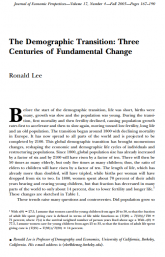
The Demographic Transition: Three Centuries of Fundamental Change

Excerpt
Before the start of the demographic transition, life was short, births were many, growth was slow and the population was young. During the transition, first mortality and then fertility declined, causing population growth rates first to accelerate and then to slow again, moving toward low fertility, long life and an old population. The transition began around 1800 with declining mortality in Europe. It has now spread to all parts of the world and is projected to be completed by 2100. This global demographic transition has brought momentous changes, reshaping the economic and demographic life cycles of individuals and restructuring populations. Since 1800, global population size has already increased by a factor of six and by 2100 will have risen by a factor of ten. There will then be 50 times as many elderly, but only ve times as many children; thus, the ratio of elders to children will have risen by a factor of ten. The length of life, which has already more than doubled, will have tripled, while births per woman will have dropped from six to two. In 1800, women spent about 70 percent of their adult years bearing and rearing young children, but that fraction has decreased in many parts of the world to only about 14 percent, due to lower fertility and longer life. These changes are sketched in Table 1.
- Issue:
- Demography, Urbanization and Migration
- Region:
- Global
- Year Published:
- 2003
- Author:
- Ronald Lee
- Institution:
- Journal of Economic Perspectives

